
Wild Lizard Chase
Monitors are the most challenging animals I've filmed in 20
years of shooting in the field. My film crews and I have
captured many elusive creatures on film, from sea snakes to
tarantulas to cuttlefish, but the lizards of the
Varanus genus were the wiliest of all. These highly
alert creatures use every trick in the book to evade human
observers and their cameras. In this slide show, get a taste
of the challenges we faced in making this film, as well as why
we call these ancient reptiles "lizard kings."—Gisela Kaufmann
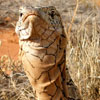

|
|
Standing tall
You might think it shouldn't be too difficult to film
the biggest lizards still walking our planet, but rest
assured, it is. This is probably why there are so few
films to have ever featured them in detail. Here, the
largest monitor in my native country of Australia, the
perentie (Varanus gigantus), which can reach over
six feet in length.
|


|
|
Living dragon
You may be familiar with the biggest and most famous
monitor, the Komodo dragon (V. komodoensis),
which can grow up to a formidable 10 feet in length.
This one is "Raja," who lives at the London Zoo. But you
may be surprised to discover that there are more than 60
species of monitors, spanning a wide range of habitats
and behaviors, shapes and sizes.
|
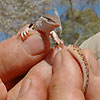

|
|
Mini monitor
There are even pygmy monitors, which are not much longer
than your finger. The smallest of all monitors is the
one seen here, the short-tailed monitor (V. brevicauda), here held by our chief scientific advisor, Dr. Eric
Pianka. All monitors, despite their size, show the same
fierce attitude and cleverness.
|
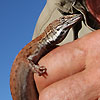

|
|
Lizard Man
Our advising scientists, including Dr. Pianka (seen here
with a rusty desert monitor, V. eremius, his
favorite lizard), warned us that it would be exceedingly
difficult to observe their behavior in the wild. It was
a warning that rang true on many occasions.
|
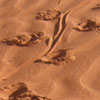

|
|
Fleet of foot
The desert monitors in particular are a class vanishing
act. They can literally disappear before your
eyes—that's if you manage to get close enough to
spot them in the first place. (Here, tracks leading to a
perentie.) Monitors can sense you from hundreds of feet
away and usually dive for cover before you know it. Or
they simply "freeze" and blend in with surrounding logs
and rocks. The camouflage of their beautiful skin
patterns can make them invisible even from close range.
|
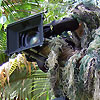

|
|
Master of disguise
All told, the monitors evaded us for long stretches, and
it took a couple of years and a huge amount of patience,
planning, and advice from our experts to finally succeed
in filming them in their natural homes. Here, Malcolm
Ludgate, our director of photography, films undercover
in Thailand.
|


|
|
Telltale sign
The most important clue to an unseen monitor's
whereabouts is the track it leaves behind, such as this
one from a perentie. Only expert trackers like Dr.
Pianka can reliably "read" a monitor's movements in the
desert sand and anticipate the animal's next move. But
following tracks can be frustrating. One minute you
clearly see the footprints, and the next, around the
next bush, they vanish on hard, shrubby ground. Or
desert winds just wipe them from the sand.
|
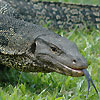

|
|
Easy going
With enough time, some monitors seemed to realize we
posed no threat and accepted our quiet presence nearby.
That's when we started getting the footage we wanted. In
general, the water monitors, including this hefty
specimen of V. salvator from Thailand, were less
wary than the desert monitors. They're still highly
alert and "switched on," but they also showed curiosity
and seemed to get used to us with more ease, as long as
we didn't move too much or too close.
|
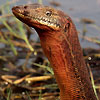

|
|
Cool customer
The mertens monitors (V. mertensi) even became
cheeky on occasion, trying to get into our bags to
snatch whatever treat they could smell. Their sense of
smell is amazing—they can detect odors right
through layers of sand and mud. And they're savvy. One
morning while filming at a lake in Australia's tropical
north, we were caught off-guard by a bush fire. With the
fire closing in, the mertens, including this one,
remained calm—they knew what lay in store. Insects
fleeing the smoke and flames soon began landing on the
lake, where the mertens were waiting for them.
|
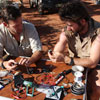

|
|
Back of beyond
The filming took us to three continents—Australia,
Asia, and North America—and certain locations made
"remote" seem too tame a word. We spent a month in
Australia's deserts, most of the time at Dr. Pianka's
research camp called Red Sands in Western Australia,
which took three days of rattling along dirt roads just
to reach from Alice Springs in Central Australia. The
camp lies a full six hours from the nearest human
outpost. This photo shows Dr. Christian Rutz (left) and
Lucas Bluff of the "lizardcam" team (see later slide)
working at the Red Sands camp.
|
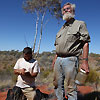

|
|
Land of sand
Keeping the team and the highly sensitive HD camera
equipment going amidst the heat, flies, and wind-whipped
sand was a challenge, but also fun—sort of. By the
end of our stay we had red sand in every pore and in
every bit of equipment, had swallowed more bush flies
than we could count, and were hanging out for a really
long shower. But it was a trip none of us will forget.
Here, the red sand behaves for once as Dr. Pianka and
his field assistant Stephen Goodyear check a pit trap.
|
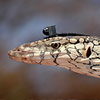

|
|
Head shot
We also managed to get the first, untested "lizardcam"
system to work in the wild. Developed by scientists at
Oxford University, this miniature camera system mounted
on the bigger desert species enabled us to get some live
footage of monitors going about their daily business. It
was truly a thrill to see how the footage beamed back to
us from unwitting participants like this perentie
excited our expert, Dr. Pianka. After 50 years of
watching lizards, the "Lizard Man" was discovering
something new. You know you've contributed to science
when that happens.
|
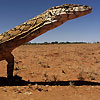

|
|
King of the lizards
Experiencing these prehistoric creatures in an ancient
land, far from civilization and guided by a witty and
passionate expert, promised at the least to be a unique
project, yet it turned out to be far more than that.
These lizard kings are not only charismatic, they're
smart, often surprising us with the way they handled
tricky situations and came up with some unexpected
solutions. Despite the hurdles involved in capturing
them on film, the monitors, including this perentie,
truly cast a spell over us.

|
|


We recommend you visit the
interactive version. The text to the left is provided for printing purposes.
|














